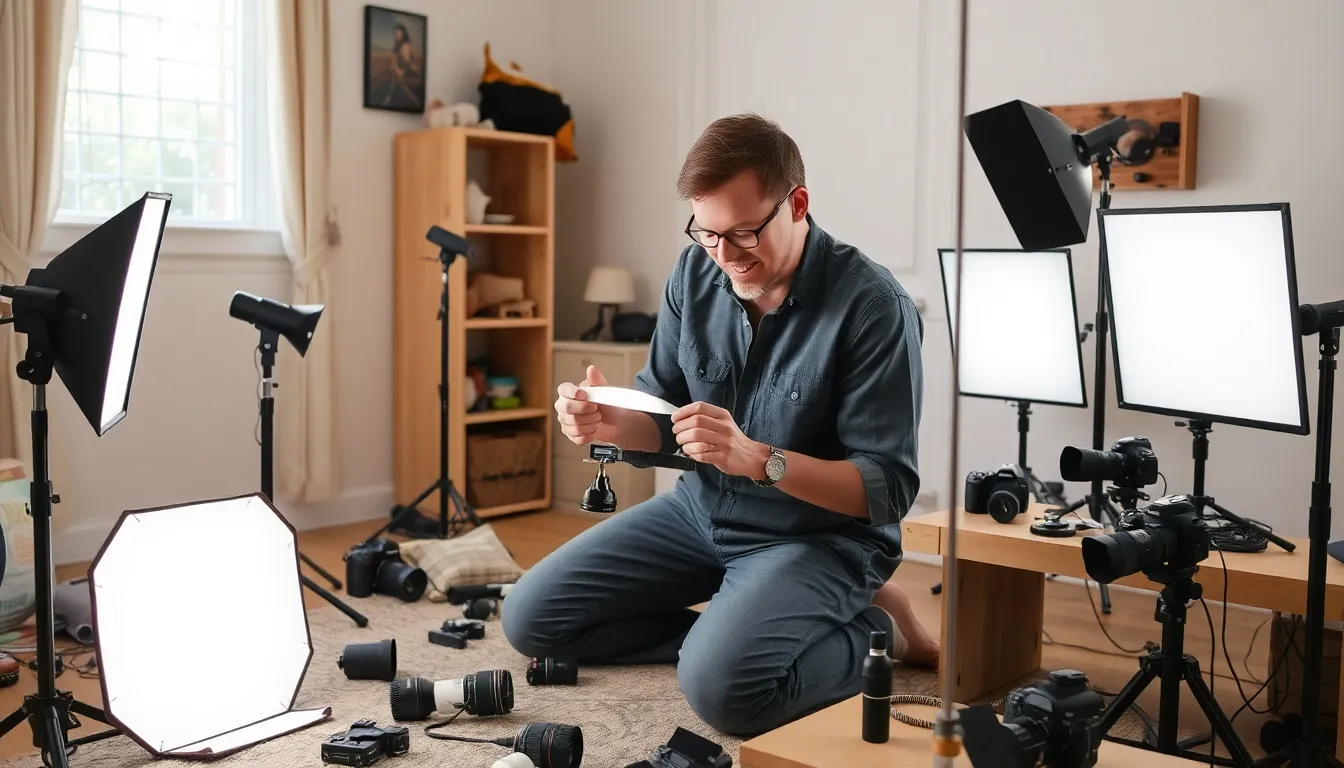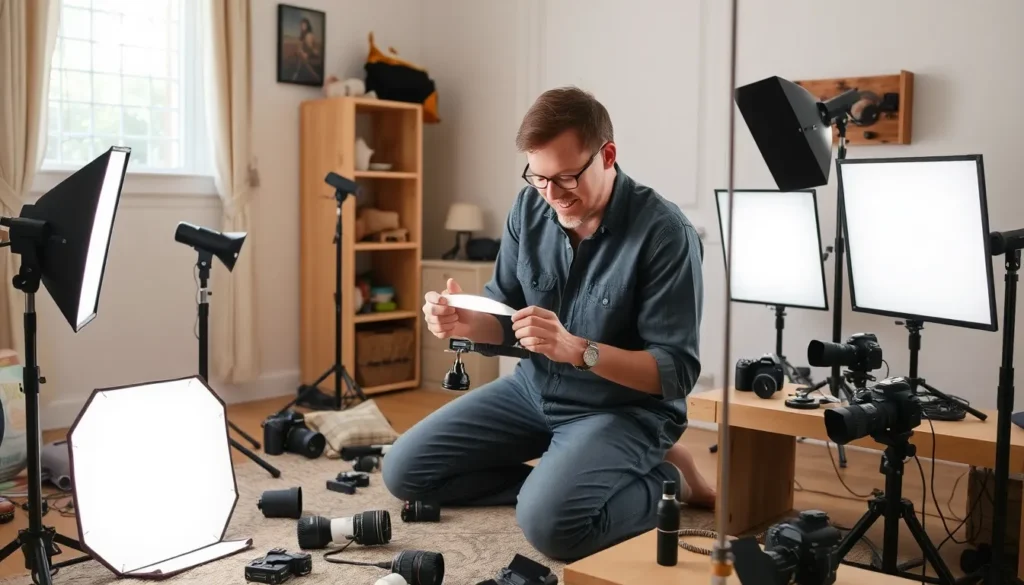In a world where everyone has a camera at their fingertips, photography DIY is gaining traction among enthusiasts and professionals alike. This creative approach empowers individuals to explore their artistic vision while mastering the technical aspects of photography. By embracing DIY techniques, photographers can elevate their skills and produce stunning images without relying solely on expensive equipment.
Whether it’s building custom lighting setups or experimenting with unique editing methods, DIY photography opens up endless possibilities. It encourages innovation and resourcefulness, allowing photographers to create captivating visuals that tell their stories. Dive into the world of Photography DIY and discover how simple, hands-on projects can transform ordinary shots into extraordinary works of art.
Table of Contents
ToggleOverview of Photography DIY
Photography DIY encompasses a variety of techniques and methods that enable photographers to create stunning images using accessible materials and equipment. This approach promotes creativity, allowing individuals to experiment with their artistic ideas and refine their technical skills. DIY photography projects can include building camera accessories, crafting unique lighting solutions, or modifying existing equipment to achieve desired effects.
Many photographers rely on simple, cost-effective strategies to enhance their images. For instance, they can create homemade reflectors using materials like cardboard or aluminum foil, significantly improving light control without significant investment. Similarly, constructing diffusers from sheer fabrics can produce soft lighting, which benefits portrait photography.
Photographers can also engage in digital DIY by editing images with free or low-cost software. Utilizing tools like GIMP or Lightroom allows for extensive adjustments, enhancing photography without professional-grade software. Online tutorials and community forums provide valuable resources and support as individuals navigate their DIY projects.
Collaboration with other photographers enhances the DIY experience, fostering a shared learning environment. Participating in workshops or local meetups can inspire new ideas and innovative techniques. This collaborative spirit contributes to the growth and evolution of DIY photography, allowing enthusiasts to showcase their unique perspectives.
Photography DIY emphasizes resourcefulness, creativity, and collaboration. By taking advantage of accessible materials and techniques, photographers can elevate their craft, producing remarkable art while minimizing costs.
Essential Tools for Photography DIY

Photography DIY requires essential tools that enhance creativity and improve technical skills. The right equipment helps in experimenting and achieving impressive results.
Cameras and Lenses
Cameras come in various types, including DSLRs, mirrorless, and compact cameras. DSLR cameras offer interchangeable lenses and advanced controls, ideal for detailed photo work. Mirrorless cameras provide a compact design with high-quality images, while compact cameras serve well for travel and casual photography.
Lenses also play a critical role; prime lenses create sharp images with wide apertures, suitable for low-light situations. Zoom lenses offer versatility for various compositions. Specialty lenses, like macro and wide-angle, can expand creative possibilities.
Lighting Equipment
Lighting equipment significantly impacts image quality. Natural light can produce stunning results but may require additional tools for better control. Reflectors direct light toward the subject, enhancing brightness. Diffusers soften harsh sunlight, creating even lighting.
Artificial lighting options, such as speedlights and continuous lights, provide flexibility in any environment. Softboxes and umbrellas can further diffuse light, resulting in a softer appearance. Understanding these equipment types allows photographers to shape the final look of their images.
Tripods and Stability Tools
Tripods provide stability and prevent camera shake, ensuring sharp images, especially in low-light situations or during long exposures. Look for tripods with adjustable height and flexibility for varied shooting angles.
Gimbals enhance stability, especially for video recording. Handheld stabilizers reduce shake in action shots, improving overall image quality. Weights can also be added to tripods for extra stability in windy conditions. Using proper stability tools allows photographers to capture clear, engaging visuals.
Creative Photography DIY Projects
Numerous DIY projects exist that enhance photography creativity while utilizing accessible materials. These projects can elevate a photographer’s work through innovative techniques.
Home-Made Light Modifiers
Home-made light modifiers significantly improve lighting quality in photography. Photographers can create simple reflectors using materials like cardboard and aluminum foil, redirecting light to enhance subjects. Crafting diffusers from sheer white fabrics helps soften harsh light, reducing shadows and creating a more pleasing atmosphere. Additionally, building barn doors from cardboard or wood allows precise light direction, adding creative flair to portraits and still life setups.
DIY Photography Backdrops
DIY photography backdrops provide versatility for diverse shoots. Photographers can use materials like bedsheets, large paper rolls, or even painted plywood to create unique backgrounds. These backdrops can be easily customized with colors or textures that suit specific themes. For outdoor shoots, landscaper fabrics or patterned tarps work well, offering creative solutions in natural settings. Simple stands made from PVC pipes hold backdrops steady for professional results.
Custom Camera Straps
Custom camera straps enhance both comfort and style during photography sessions. Photographers can repurpose old fabric, leather, or even seatbelt material to design personalized straps that reflect their style and needs. Adding padding from foam or thick fabric increases comfort during extended shoots. Decorative elements like beads or embroidery personalize the strap further, making it a distinctive accessory that showcases individual creativity.
Tips for Successful Photography DIY
Successful photography DIY combines creativity and technique. Implementing effective strategies enhances the overall quality of images.
Experimenting with Techniques
Experimenting with techniques broadens a photographer’s skill set. Incorporate various methods like long exposure, double exposures, or light painting to achieve unique effects. Use a tripod for stability during long exposure shots, ensuring clarity in images. Adjust camera settings to test different apertures and shutter speeds; this variation reveals distinct outcomes. Capture different angles and perspectives, driving innovation in compositions. Analyze results to understand the impact of each technique, and adapt future projects based on insights gained.
Utilizing Natural Light
Utilizing natural light maximizes image quality while minimizing costs. Position subjects near windows or in open outdoor spaces for optimal lighting. Observe the time of day; golden hour, just after sunrise or before sunset, offers soft, warm light that enhances photographs. Use reflectors, made from white boards or aluminum foil, to bounce light and fill in shadows. Control harsh sunlight by finding shaded areas or using diffusers; this technique softens light and reduces glare. Incorporating natural light into DIY photography instills a sense of realism and enhances the overall aesthetic of images.
Photography DIY opens up a world of possibilities for both novice and experienced photographers. By embracing creativity and resourcefulness, individuals can transform their photographic journey without breaking the bank. The ability to craft unique accessories and modify existing tools fosters a deeper connection to the art form.
Exploring DIY techniques not only enhances technical skills but also encourages a spirit of experimentation. Whether it’s through building custom lighting solutions or editing images with accessible software, photographers can discover new ways to express their artistic vision.
Ultimately, photography DIY is about more than just saving money; it’s a celebration of creativity and collaboration that enriches the photographic community. With each project, photographers can elevate their craft and create stunning images that truly reflect their unique style.



